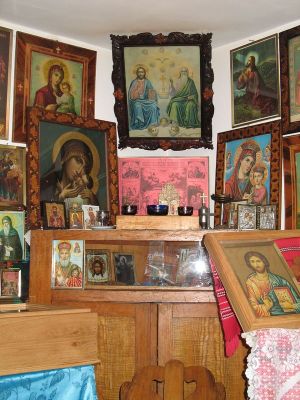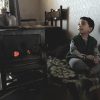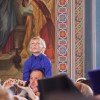Source: The Antiochian Orthodox Christian Archdiocese of North America
 As Orthodox Christians, we have been taught that our homes are “little churches.” This has been true since the early church of the Apostles, when the first services were held in the homes of the faithful. St. Paul extends greetings to his fellow Christians in Romans 16:5 “Greetings also to the church that meets in their house.” And if this is to be true, then our “little churches” will have not only the Holy Bible, candles to light, incense to burn, and icons; lots and lots of icons.
As Orthodox Christians, we have been taught that our homes are “little churches.” This has been true since the early church of the Apostles, when the first services were held in the homes of the faithful. St. Paul extends greetings to his fellow Christians in Romans 16:5 “Greetings also to the church that meets in their house.” And if this is to be true, then our “little churches” will have not only the Holy Bible, candles to light, incense to burn, and icons; lots and lots of icons.
Growing up, icons were always a part of my life. In a corner of the bedroom I shared with my older sister were icons of Christ with the Theotokos and icons of our patron saints. Each night before we went to sleep, my mom would light the electric “kandili” in front of the icons. Once it was lit, I could see the faces of the Theotokos and Christ glowing with warmth in the soft light. Then, and only then, could I go to sleep, knowing I was safe in their presence.
At my Yiayia and Papou’s house, my Yiayia had a prayer alcove where she said her daily prayers. I can still see her kneeling at her little altar, in her nightgown and robe, surrounded floor to ceiling by the icons she had brought with her from Greece. I would hide and listen to her whisper her prayers in Greek. She would turn to me and invite me to join her, but I hung back waiting for her to finish. After she went to bed, I would quietly go into the alcove and sit on the kneeling stool. This was my time to “dialogue” with the saints and, especially, with the Theotokos, who always seemed so friendly and understanding about whatever I had on my mind. In that alcove, I was safe, welcomed and peaceful, surrounded by so many loving faces.
In the autobiographical account of his coming to America, A Place for Us, Nicholas Gage, tells of the comfort and safety he too felt in the presence of icons. Nine year-old Nicholas had been raised in a very remote and primitive mountain village in Greece during WWII, when he and his older sisters escaped from the Communists. With the help of relatives, they made their way to Boston to live with their estranged father. Everything that they saw and heard in Boston was foreign to them. Then their father takes them to Sunday Divine Liturgy. Once inside the church, they are at home. They are greeted by the familiar smell of the church incense, they light their candles and hear the familiar words of the hymns sung in Greek and, of course, they recognize the “ascetic faces of the saints” in the icons all around them. Nicholas’ father volunteers him to lead the congregation in the “Our Father” at the appropriate time. He stands at the solea, frightened and alone. But he looks up and sees the familiar face of Christ Pantocrater looking down on him. Nicholas recalls how back home the Pantocrater always seemed to be frowning at him for all of his misdeeds. But now His look was one of love and compassion. And so, reassured by this familiar face, he happily recites the “Our Father”.
Even now icons in our homes have meaning for our children. Susie Sobchak, the church school director at St. George Church in Houston, shares her family’s Hurricane Rita evacuation experience. “We had our girls pack for the evacuation. It was left to their discretion to pack items of importance to them should we come back and find the house all torn up. Amongst their stuffed animals and toys, they took their icons of their saints off the walls of their room and packed them (without any prompts from us). We took all of our smaller icon cards that we had and taped them to the windows facing out. We especially looked for all of our St. Nicholas ones so that he might calm the storm for us. And God was gracious and spared us. It was heartwarming to see that the children know what ‘treasures’ to value.”
As Christian Education coordinator, I have had the opportunity to visit the parishes around our diocese and I have been welcomed into many homes. At almost every home, the focal point has been their icons. Almost without fail, a story comes with the special icons, whether it is the circumstances under which the icon was obtained or a special healing or grace that came with the icon.
Icons in our homes, our “little churches,” remind us that God is with us, always. They remind us to pray. They are witnesses to Who it is that is “The Way, They Truth and The Life.” They are examples of the path we must follow if we are to live a life of godliness. Icons are the perfect counterpoint to the many dark and ungodly images that invade our homes through the electronic media. And if we give them a prominent enough place in our homes and our lives, those images imprint themselves on our hearts, minds and souls. They will not only be “windows into heaven”, but the safe haven in the storm, the place where we can go and feel welcomed. We should make every effort to recreate the “little church” in our homes, for the sake of our children and ourselves. Just as God’s name should be the first word we speak when we wake and the last word before we go to sleep, the first and last image of the day should be Our Lord and Saviour, Jesus Christ, His saints and His uncreated life-giving light.















